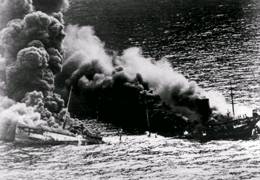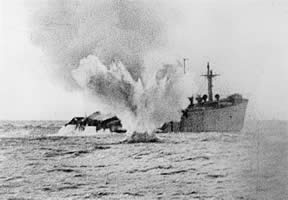
|
Battle of the Atlantic
The Fall of France
May 10, 1940. The German army launched its long awaited invasion of France. By nightfall, panzers swept through Holland and Luxembourg and were marching towards Belgium. By May 25, the British army was pushed back and driven off the continent at Dunkirk. May 28, Belgium capitulated. The Blitzkrieg which claimed Poland, Denmark, Norway, Holland and Belgium was now heading for France. By June 22nd, the Battle of France is over. The Battle of Britain is about to begin.

|

|
| German panzers sweeping through France. | Within six weeks, the Battle of France is over. |
The next phase of the war was to be very successful for the u-boat force. The occupation of France was a strategic step forward for Donitz, who had moved his HQ to Paris and assumed personal command of the Atlantic operations. With the French ports of Brest, Lorient, St. Nazaire, La Pallice and Bordeaux, u-boats no longer need to make lengthy voyages around the British Isles to reach the Atlantic. These ports were rapidly occupied and turned into fully functional u-boat bases capable of refueling, rearming and repairing u-boats. By July 7 1940, the first u-boat, U-30 (Lemp) sailed into Lorient. Shorter voyages meant more days spent on patrol, while the strategic location of the French ports extended the operational coverage of u-boats. In effect, the acquisition of new Atlantic ports on the French coast greatly increased the presence of u-boats in the Atlantic.
The second strategic advantage on the fall of France was that Britain itself was open to invasion fears. Immediately after the French defeat, Italy joined the war on the Axis side – leaving Britain to stand alone. Hitler began preparing for the invasion of the British Isles, dubbed Operation Sea Lion. As a result, many British destroyers were held back in home waters to defend against an invasion threat, which in turn reduced the number of vessels available for escort duty. Furthermore, with the elimination of the French Navy, the British were forced to extend their coverage to the Mediterranean – a task previously performed by the French navy. Although by now the British had instituted the convoy system - which reduced the number of highly vulnerable targets sailing on their own, Britain itself was hampered with a shortage of escorts for convoy duty. Nonetheless, the shortage of escorts would continue to plague the convoys exposing them to dangers of u-boat attacks.
Finally, the most decisive factor with the acquisition of the French bases was they permitted the tactic of “Wolf Packs” to be put to practice. Known to the Germans as Rudeltaktik, Donitz was not able to implement this tactic earlier due to several factors. The first was the lack of powerful radio transmitters capable of sending messages across the Atlantic. The second was the shortage of boats and last was the lack of suitable bases for which to exercise the close tactical control necessary for the co-ordination of the attack. Although Donitz would continue to face a shortage of boats, but the acquisition of the French bases lifted the other hindrances as France possessed powerful land based radio transmitters and suitable bases for which to co-ordinate the attack.
In a separate development, the Italian Navy had at their own initiative set up an Atlantic base at Bordeaux. Known as Betasom, from November 1940 until the Italian armistice in 1943, Italian submarines served under German operational control, but under Italian command. Tensions ran high between the German u-boat force and their Italian counterparts, with Donitz developing a very poor opinion of their capabilities.

|

|
| Donitz visiting the Italian base Betasom, in Bordeaux. Established 1st September 1940, Italian u-boats served under German command, but reported to the Italian navy. | Italian u-boat Archimede on dock at Betasom. She participated together with German u-boats in pack attacks. |
Implemented in July 1940, wolf pack operations brought immediate and dramatic results. With frequent help from B-Dienst, u-boats carried out waves of attack after attack on convoys, inflicting heavy losses with minimal losses to themselves. Coinciding with a decline in torpedo failure, this period came to be known to the u-boat crews involved as the “Happy Time”.
Wolfpack tactics called for the mass coordinated attack of several u-boats on a single convoy. The first boat to make contact was known as the “shadower”, whose job was to maintain contact and provide information about the convoy’s size, location, course and speed. The shadower would often remain just out of sight of the convoy and would sometimes shadow it many for days while a pack was forming. These were sometimes aided with the Focke-Wulf Kondor reconnaissance plane, who would relay convoy sightings back to BdU. Other u-boats in the area would converge on the convoy and when enough boats have been assembled, they would be ordered to attack in one massive blow, overwhelming the escorts and scattering the convoy. BdU would exercise close tactical control on the attacking boats until the moment of the actual attack - in which the final procedure was always in the hands of the u-boat captain.
U-boats would close in on the surface, at night and preferably with the moon behind their backs, where their low silhouettes made them almost invisible to convoy lookouts. The underwater detection gear, or ASDIC used by the escorts were useless on a surfaced u-boat. Until radar technology had advanced enough to be used on shipboard vessels, u-boats captains would close in on the surface virtually undetected. Furthermore, surfaced u-boats were faster than many escorts, which were old vintage WW1 destroyers designed primarily to counter slow moving submerged submarines. Since convoys sailed at the fastest speed of the slowest ship, speed was not of paramount importance for the escorting vessels. Finally, there were simply too few escorts available to provide adequate convoy protection. U-boat captains would attack simultaneously from a distance between 700 and 5000 meters. Torpedoes would be launched at the overlapping targets from the furthest first to the closest – so as to achieve simultaneous explosions at the same time – concealing the few vital extra moments of an attack. Until the British devised counter measures to these weaknesses, wolfpack successes against allied shipping continued to mount to epic proportions.
From July until October 1940, over 220 allied ships were sunk. The first successful wolfpack attack occurred on the night of September 21st 1940. Convoy HX72 consisting of 42 merchantmen was repeatedly attacked by four u-boats, with eleven ships sunk and two damaged. In a space of just over three hours, Kapitanleutnant (KL) Otto Kretschmer in U-99 sank three ships and Joachim Schepke (U-100) accounted for seven. Another ship was sunk and yet another damaged by KL Bleichrodt, while KL Jenisch (U-32) damaged one more.

|

|
| A stricken merchant struggles to stay afloat in the Atlantic. | Broken in two by a torpedo, this tanker sinks beneath the waves. Torpedoes with magnetic pistols exploded beneath the target, breaking the hull in two. |
October 5th 1940, convoy SC7 departed Ontario bound for Liverpool. Composed of 34 ships deployed in nine columns, for the first eleven days, the convoy was guarded by a lone escort sloop. The first attack came in the early hours of October 16th, on Rockall Bank, west of Scotland. Seven u-boats converged and attacked – sending ship after ship to the bottom. Twenty were sunk, including six torpedoed by Otto Kretschmer. The escort screens could do nothing but pick up survivors of the attack. Of the 34 ships, only 12 made it to port, and that too was because Otto Kretschmer received news that another large convoy HX79 was coming into range behind them. On October 19th, the second convoy battle ensued. Five u-boats attacked convoy HX79, with another twelve ships going down and two damaged (out of 49). Six were torpedoed by Gunther Prien (U-47). U-boat commanders and propagandists referred the combined attacks on SC7 and HX79 as the “Night of the Long Knives”, after the infamous 1934 execution of party officials. Finally on December 1st, ten u-boats (including three Italian boats) caught the fast moving convoy HX90 and torpedoed 13 ships, of which ten were sunk and three damaged.
The wolfpack attacks were extremely successful, leading to a colossal slaughter of British shipping. In the three month period from September 2 to December 2 1940, 157 allied ships had been sunk for a total of 847,000 tons. In the same period, only three u-boats had been lost, making the exchange rate of 1 to 52 - a horrendous rate of loss. Oil imports in Great Britain fell to half the normal rate covering only two thirds of her consumption. This rate of loss would soon bring Britain to her knees. Such was the calamity of the looming crisis, that it was at this point that British Prime Minister Winston Churchill had privately confided that he feared the Battle of the Atlantic may have been lost – along with Britain’s ability to continue fighting.
A sustained effort had to be done to return the initiative back to the British. For this, the Admiralty concentrated on a number of strategies. Starting with the need to increase the number of convoy escorts, many destroyers on invasion watch were reassigned to convoy duty. Further, newly constructed corvettes and small warships below 1000 tons were also assigned to convoy duty. Even more importantly, the British managed to negotiate a loan of fifty old model destroyers from the United States – adding significantly to the number of available escorts. The increase in available escorts would help plug gaps in the escort screens.

|

|
| Old four stack destroyers were often used as escorts. Slow and unwieldly, they had difficulty coping with rough seas. Their old boilers also emitted thick black smoke which can be seen for miles. | Focke Wulf Condor, the eyes of Germany's u-boat wolfpacks was formed after B-Dienst went deaf when the British changed Naval codes. This aircraft earned Churchill's curse as "the scourge of the Atlantic". |
The second British strategy was the formation of permanent escort groups specially trained for convoy protection. Whereas previously, escorts were assembled from any available vessel, now escorts would undergo training in anti-submarine warfare. The crews were trained to work as a team, to hunt and sink u-boats before they were released for convoy duty.
Newly developed weapons and equipment also began to reach the battlefield. Escorts were now equipped with improved short range radios and crude radars. These early radars were not sensitive enough to detect a surfaced u-boat – nevertheless, coupled with the radio, escort skippers could map out the location of convoy ships and other escorts. The improved radios were also capable of communicating with other anti-submarine aircraft. This allowed a much closer coordination among the escorts of a convoy – especially when carrying out an attack on a submerged u-boat. For self-defense, and to repel against surfaced u-boat attacks, more and more merchant ships were now being armed with makeshift deck guns.
On August 1940, the British switched naval codes. After one full year of war, the British realized that the old Administrative code had been broken, and replaced it with the new “Naval Code Number 1”. Suddenly B-Dienst went “deaf” and was no longer able to provide convoy intelligence information. The Germans were hopeful that the new naval codes could be broken in about six weeks, but this was not to happen. In view of the absence of tactical information from B-Dienst, Hitler agreed to place Luftwaffe Gruppe 40 under Donitz’s command. This squadron consisted of Focke Wulf Condor reconnaissance planes, which acted as convoy spotters for the Kriegsmarine.

|

|
| The wake of a torpedo could be spotted by a sharp lookout. Early gas powered torpedoes (G7a) left a telltale sign of bubbles. The later electric versions (G7e) were wakeless. | U-boat shelling a merchant after a torpedo hit. Later in the war merchants were fitted with deck guns for self defense against such attacks. |
Meanwhile, Winston Churchill was rallying for support from the United States, in what he correctly viewed as the most decisive measure to defeat the Germans. Washington had all this while watched in awe at the epic losses of British shipping and had concluded it was just a matter of time before Britain falls. Should this happen, Washington felt that Latin America itself was threatened by a powerful Axis force – Japan in the east, Germany and Italy in the west. On August 1940, top secret joint military planning began between Great Britain and the United States. September 27 1940 saw the signing of the Tripartite Pact, which was a detailed joint plan for waging war against the Axis forces, including Japan. During a visit to London on January 1941, White House advisor Harry L. Hopkins told Churchill: “The President is determined that we shall win the war together”. In public, Roosevelt continued to insist the United States would not go to war, but the “Destroyer Deal”, Lend-Lease, and other measures were merely helping hands to a friend.
By March 1941, these counter measures were beginning to have some effect. That month itself, no fewer than three u-boat aces were lost. The Bull of Scapa Flow, Gunther Prien in U-47 was lost on March 7, with all hands onboard near Rockall Banks, west of Scotland. Possible reasons included mines, hit by its own torpedo or sunk by British corvettes. The next u-boat ace to fall was Joachim Schepke in U-100. On March 17, U-100 was detected on radar by HMS Vanoc, southeast of Iceland - the first time a u-boat had been located by radar. The British destroyers Walker and Vanoc closed in to the chase and rammed U-100 in heavy fog. 38 men were killed, including Schepke who was crushed on the bridge. During that same battle, Otto Kretschmer in U-99, was so heavily depth charged by HMS Walker, that he was forced to surface and abandon, with 40 of his 43 crew surviving. They were sent to POW camps.
For the u-boat crew, the “Happy Time” was over - the British had learnt to fight back.



